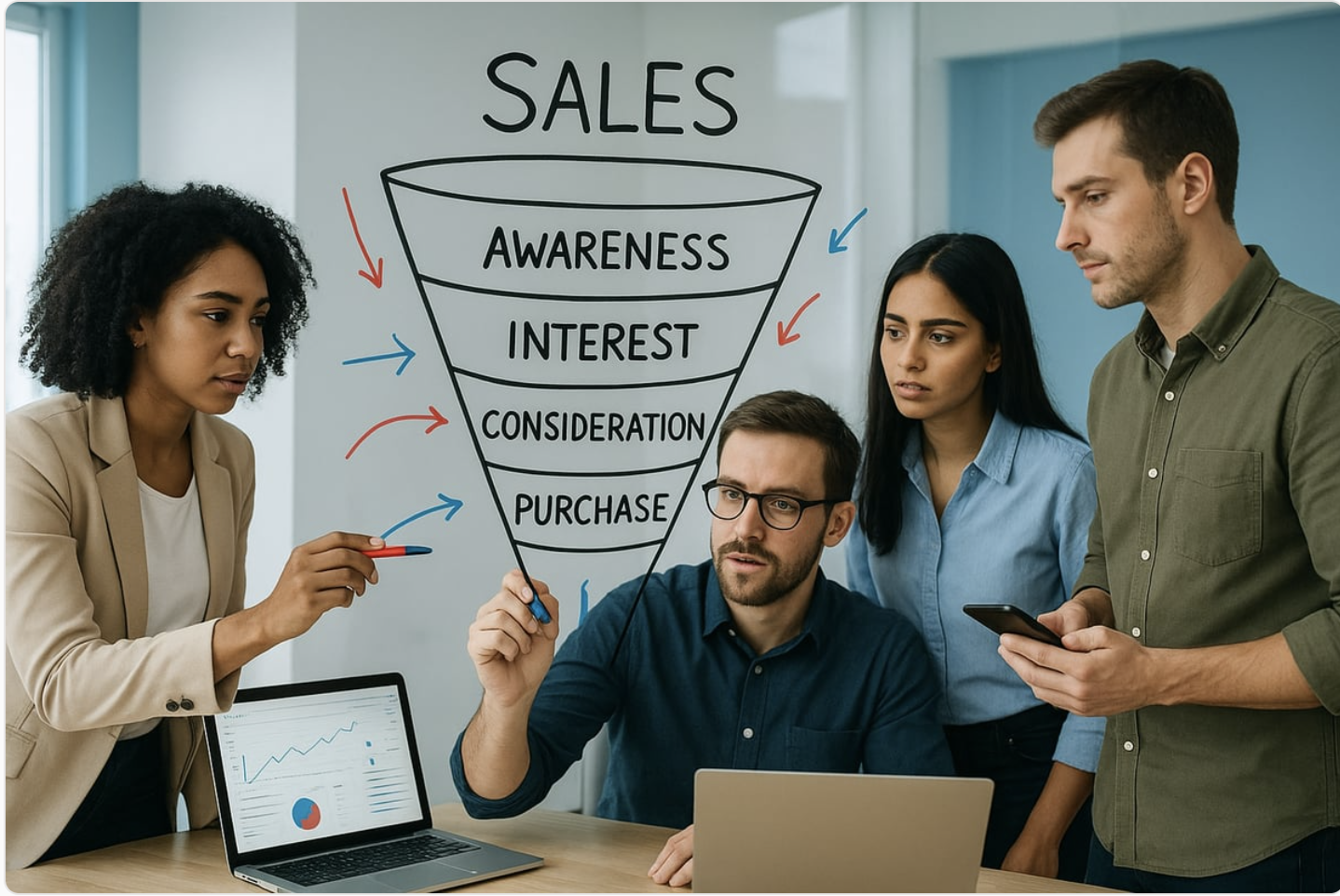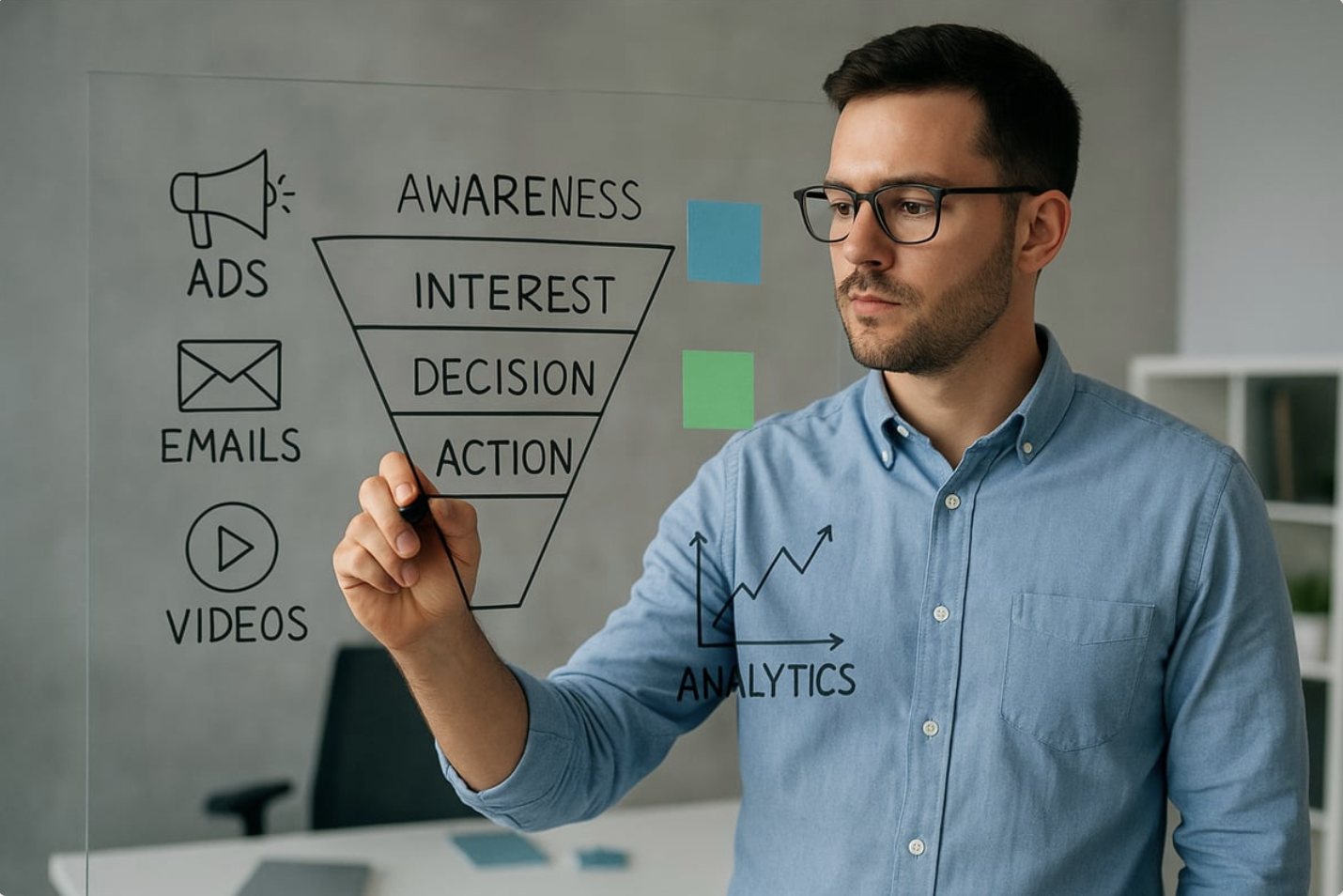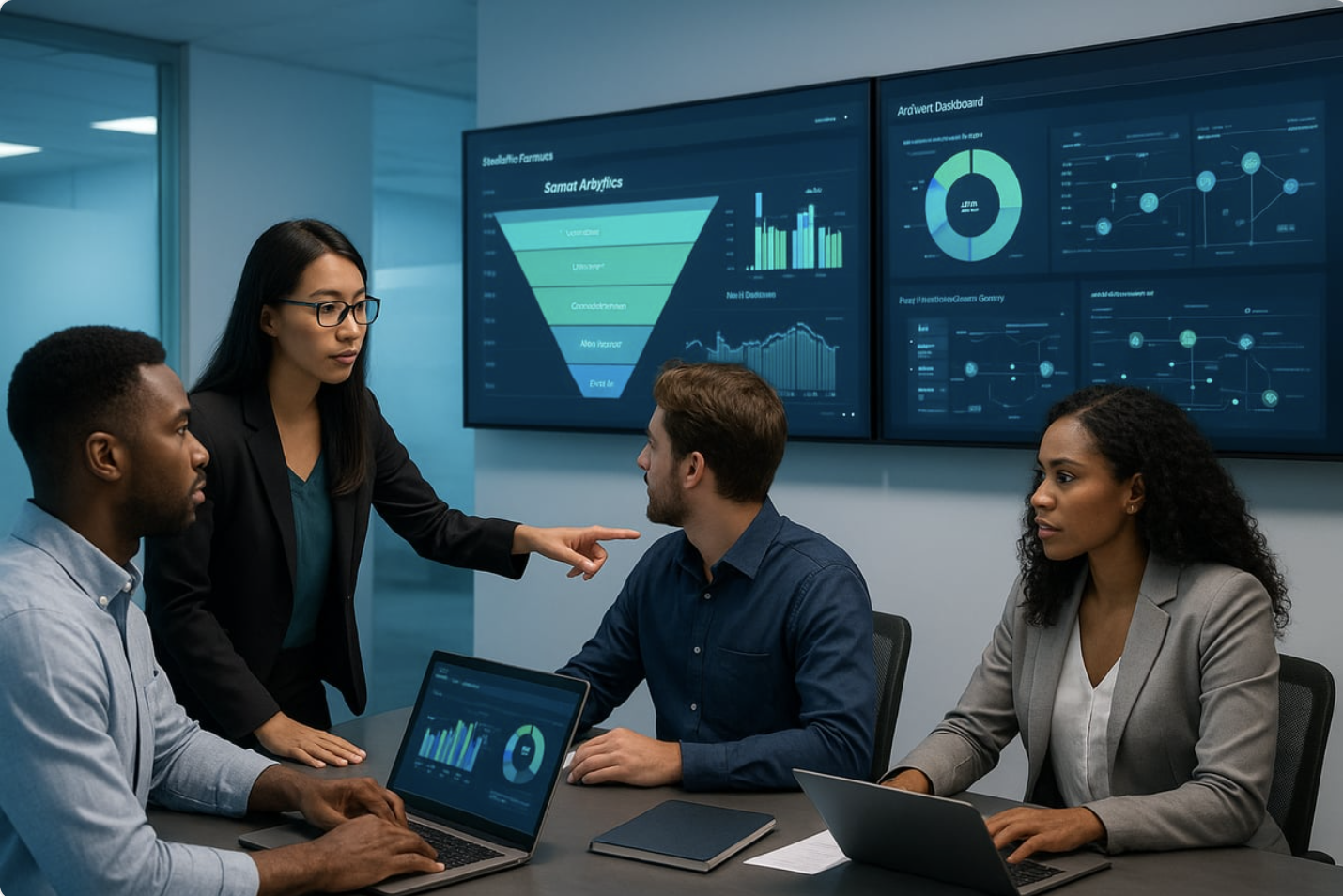In 2026, mastering your funnel framework isn’t just a competitive edge, it’s a necessity for sustainable growth. Did you know 68% of companies still lack a defined funnel framework, leading to missed sales and stalled growth?
Businesses that implement a structured funnel framework often see triple-digit lead growth and significant revenue expansion. This guide will give you the latest frameworks, real-world examples, and actionable insights to help you build, optimize, and scale a funnel framework that converts.
Ready to transform your sales strategy? Dive in to discover the fundamentals, proven step-by-step frameworks, practical examples, and advanced optimization techniques designed for the digital landscape ahead.
Understanding Funnel Frameworks: The Foundation of Modern Sales
In today’s digital-first world, a well-constructed funnel framework is the cornerstone of scalable sales success. Businesses of all sizes are turning to frameworks that map the buyer’s journey and guide prospects from first touch to loyal customer. But what exactly is a funnel framework, and why is it so vital for sales in 2026?
What is a Funnel Framework?
A funnel framework is a structured system that guides potential customers through each stage of the buying process. Its main purpose is to create predictability and scalability in digital marketing and sales.
Unlike traditional sales processes, which often rely on one-size-fits-all pitches or isolated campaigns, a funnel framework maps every step of the buyer’s journey. This method ensures prospects receive the right message at the right time, increasing the likelihood of conversion.
Key differences between classic sales and funnel-driven strategies include:
Predictability: A funnel framework allows you to forecast results based on data, not guesses.
Scalability: Once built, it can be optimized and expanded across channels.
Personalization: Frameworks adapt to buyer behaviors and preferences.
For example, many successful businesses use a “Fill-Your-Funnel” 6-step structure. This approach breaks down the journey into clear stages, helping teams visualize and optimize each touchpoint. By mapping the buyer’s path, a funnel framework transforms chaotic sales efforts into a streamlined process.
Why Funnel Frameworks Matter in 2026
In 2026, the stakes for using a funnel framework are higher than ever. According to Salesforce, 79% of marketing leads are never converted without a proper framework in place. This means companies without a defined funnel framework risk losing the majority of their prospects.
Modern sales funnels are shaped by several evolving trends:
Automation and AI: These technologies add complexity, enabling real-time personalization and multi-channel engagement.
Customer expectations: Buyers now expect tailored experiences and seamless transitions between platforms.
B2B vs. B2C: Whether in SaaS or e-commerce, a funnel framework helps both sectors manage long sales cycles or rapid-fire transactions.
Leading companies that embrace a funnel framework report sustainable revenue growth, consistent lead generation, and higher customer retention. Frameworks are evergreen, working across Facebook, Google, TikTok, and even the latest emerging platforms.
With these advantages, it’s no surprise that businesses with structured funnels see triple-digit lead growth and multi-fold revenue expansion. The funnel framework is no longer optional—it’s a strategic must-have for 2026 and beyond.
Key Elements of a Successful Funnel Framework
A high-performing funnel framework has several core components:
Awareness: Attracting attention from your ideal audience.
Interest: Educating and engaging prospects with valuable content.
Decision: Presenting offers and addressing objections.
Action: Encouraging conversion through clear calls-to-action.
Retention: Keeping customers engaged and loyal post-sale.
Success comes from integrating campaigns, content, and channels into a unified system. Tracking, analytics, and feedback loops are essential for continuous improvement. Alignment between marketing and sales teams ensures consistent messaging and a seamless buyer experience.
The “Dream 100” concept is also key: focus on targeting your most valuable audiences for maximum impact. To see how these principles are applied in practice, you can read our methodology for proven funnel frameworks and strategies.
Mastering these elements is what sets apart high-growth organizations from the rest. With the right funnel framework, you can turn every stage of the buyer’s journey into a growth opportunity.
The Step-by-Step Funnel Framework for 2026: Chronological Guide
Mastering the funnel framework in 2026 means following a clear, actionable process that turns strangers into loyal customers. This step-by-step guide breaks down each stage, helping you build a funnel framework that adapts to modern buyer journeys, leverages technology, and drives real growth.
Step 1: Define Your Audience & Offer
The first step in any funnel framework is to clearly define who you want to reach and what you will offer them.
Start by identifying your ideal customer profile (ICP) and developing detailed buyer personas. Research their pain points, goals, and what motivates them to take action.
Next, craft offers that match their needs at every stage. These could be:
Lead magnets (free guides, checklists)
Tripwire offers (low-cost products to build trust)
Core products or services
For example, a tripwire funnel framework uses a low-cost entry offer to convert cold leads into paying customers, breaking down initial barriers and building momentum.
By tailoring offers and audience targeting, your funnel framework becomes much more effective from the very first interaction.
Step 2: Map the Funnel Stages
Mapping out the funnel stages ensures your funnel framework aligns with the entire buyer journey.
Break your funnel into three main sections:
TOFU (Top of Funnel): Awareness and education content
MOFU (Middle of Funnel): Nurture leads and present solutions
BOFU (Bottom of Funnel): Drive conversions and close sales
Assign the right content and call-to-action (CTA) to each stage, such as blog posts or ads for TOFU, webinars or case studies for MOFU, and sales pages for BOFU.
A squeeze page funnel framework, for example, is perfect for capturing leads at the TOFU stage and guiding them to the next step.
Mapping these stages helps you deliver the right message at the right time, keeping your funnel framework customer-centric and effective.
Step 3: Select and Integrate Channels
A successful funnel framework uses multiple channels to reach and engage prospects wherever they are.
Choose the platforms that best match your audience, such as:
Paid ads (Facebook, Google, TikTok)
SEO and content marketing
Email campaigns
Webinars and podcasts
Social media
Integrate these channels for a seamless experience. For instance, a webinar funnel framework can combine paid ads for registration, email reminders, and follow-up sequences to maximize conversions.
Adapting your funnel framework to each channel ensures you never miss an opportunity to connect with your audience and move them through the funnel.
Step 4: Build High-Converting Funnel Assets
Your funnel framework relies on the quality of its assets. These include:
Landing pages and opt-in forms
Sales pages with persuasive copy
Video sales letters (VSLs) for deeper engagement
Use visuals and videos, since 54% of consumers prefer video content. Write clear, benefit-driven headlines and CTAs.
A video sales letter funnel framework, for example, can dramatically boost conversions by combining storytelling, visuals, and a compelling offer.
Each asset in your funnel framework should work together to guide prospects smoothly from one stage to the next, reducing friction and increasing results.
Step 5: Nurture and Convert Leads
Nurturing leads is a critical part of any funnel framework. Use automated email sequences to educate, build trust, and address objections.
Incorporate:
Retargeting ads to re-engage visitors
Indoctrination pages to introduce your brand values
Anticipation-building for upcoming launches
For instance, a product launch funnel framework uses teaser content and personalized emails to warm up leads before the big reveal.
Behavioral triggers and segmentation make your funnel framework smarter, delivering the right message at the right time to convert more leads.
Step 6: Optimize, Analyze, and Scale
The final step in the funnel framework is ongoing optimization. Track key metrics like conversion rates, customer acquisition cost (CAC), lifetime value (LTV), and return on investment (ROI).
Run A/B tests on your assets and campaigns to find what works best. Use analytics dashboards and feedback loops to refine your funnel framework continuously.
As your funnel framework grows, automation and segmentation allow you to scale without sacrificing personalization. To streamline this process and achieve even better results, consider exploring services for funnel optimization to maximize every stage of your sales funnel.
A well-optimized funnel framework is never static. Keep testing, learning, and scaling to stay ahead in 2026’s fast-changing digital landscape.
Real-World Funnel Frameworks: Proven Models for Every Business
Unlocking the power of a funnel framework is the key to consistent growth in any industry. The right funnel framework transforms scattered sales efforts into a repeatable, scalable engine. Below, you’ll find five proven frameworks that businesses use daily to drive leads, sales, and loyalty. For more on how experts build these systems, see About our digital marketing expertise.
Tripwire Funnel: Turning Cold Leads into Customers
The tripwire funnel framework is designed to convert cold prospects into buyers with a low-friction, irresistible offer.
Structure: Low-cost entry offer → Upsell (one-time offer) → Confirmation page.
Why it works: This funnel framework lowers the barrier for first-time buyers, creating trust and increasing the likelihood of future purchases.
Example: Offer a free product plus shipping, then present a higher-value upsell after checkout.
Data: After customers enter payment info, conversion rates for upsells spike.
When to use: Perfect for e-commerce, SaaS trials, and digital products.
A tripwire funnel framework helps you build momentum with new audiences, setting the stage for long-term relationships.
Webinar & Auto-Webinar Funnels: Education-Based Selling
If your business thrives on trust and education, the webinar funnel framework is a game-changer.
Structure: Registration → Indoctrination sequence → Live or automated webinar → Sales offer.
Why it works: This funnel framework delivers real value, warms up leads, and closes with urgency or limited-time bonuses.
Example: A SaaS platform runs weekly demos, while coaches use auto-webinars for evergreen sales.
Data: Live webinars initially convert best, but auto-webinars scale up winning presentations.
Best practices: Choose hot topics, send follow-up emails, and offer replays.
With this funnel framework, prospects learn, engage, and buy—all in one seamless journey.
Squeeze Page & Lead Magnet Funnels: List Building Essentials
Growing your email list is easier with a squeeze page funnel framework.
Structure: Opt-in with a lead magnet → Thank you or next-step page.
Why it works: This funnel framework attracts prospects with high-value content in exchange for their contact info.
Example: Offer an ebook, checklist, or free tool to encourage sign-ups.
Data: Simplicity in design and offer increases opt-in rates.
When to use: Great for content marketers, SaaS startups, and product launches.
A squeeze page funnel framework sets the foundation for ongoing nurturing and future sales.
Product Launch Funnels: Building Anticipation and Demand
A product launch funnel framework is designed to build excitement and maximize first-day sales.
Structure: Opt-in page → Pre-launch content (videos, emails) → Launch sales page.
Why it works: This funnel framework leverages anticipation, scarcity, and early engagement.
Example: A SaaS company collects leads, sends teaser videos, then launches with a special offer.
Data: High pre-launch engagement directly boosts day-one conversions.
Tactics: Use surveys, teasers, and early access incentives.
This funnel framework ensures your audience is primed and ready when your product goes live.
Video Sales Letter & Application Funnels: High-Ticket & Personalized Sales
For high-value offers, the VSL and application funnel framework filters and converts the best leads.
Structure: Video sales letter → Offer → Application/qualification form → Sales call.
Why it works: Video increases engagement and trust, while applications ensure only qualified leads progress.
Example: Agencies and consultants use this funnel framework to pre-qualify leads before booking calls.
Data: Video boosts time on page by 88% and increases quality lead submissions by 66%.
Application funnel: Screens for fit, saving your team time and improving ROI.
Choosing the right funnel framework from these models can transform your sales approach. Each is proven, adaptable, and powerful for businesses serious about growth.
Advanced Funnel Optimization: Strategies for 2026 and Beyond
Unlocking the full potential of your funnel framework in 2025 requires more than just following the basics. Today’s digital landscape rewards those who embrace advanced strategies, from AI-driven personalization to seamless omnichannel integration. Let’s explore how to future-proof your funnel framework and drive results in an ever-evolving market.
Personalization & AI in Funnel Frameworks
Personalization is at the heart of every successful funnel framework. In 2026, leveraging AI for dynamic content and predictive recommendations will be standard practice. AI enables marketers to customize every touchpoint, adapting offers, messaging, and timing based on user behavior and real-time data.
Modern platforms use advanced segmentation to deliver tailored experiences. For example, an AI-driven email sequence can automatically adjust its messaging and cadence as a prospect interacts with your content. This approach not only increases engagement but also improves conversion rates throughout the funnel framework.
According to the AI and Customer Experience Report, buyers now expect intelligent, context-aware communication at each stage of their journey. Implementing AI tools to analyze behavioral signals and trigger next-best actions is no longer optional.
Use AI chatbots to qualify leads and answer questions instantly.
Deploy predictive analytics to recommend products or content.
Create dynamic landing pages that adapt to visitor profiles.
Staying ahead means embedding personalization and AI at every stage of your funnel framework.
Multi-Channel & Omnichannel Funnel Integration
The modern funnel framework thrives on seamless multi-channel orchestration. Buyers interact with brands across web, mobile, social, and even offline touchpoints. Integrating these channels into a unified journey is essential for maximizing conversions.
Omnichannel funnels rely on attribution modeling and cross-channel analytics. This helps marketers understand where prospects engage most and which messages drive action. For instance, a lead who attends your webinar might later see a retargeting ad on Facebook, then receive a follow-up email.
Sync messaging and offers across platforms for consistency.
Track user paths from social ads to email nurture and sales calls.
Use attribution data to identify high-performing channels.
A robust funnel framework ensures every interaction is connected, creating a frictionless experience that boosts lifetime value and loyalty.
Funnel Automation and Scalability
Automation is the engine powering scalability in any funnel framework. By automating repetitive tasks like lead capture, nurturing, and qualification, you free up time to focus on strategy and creative optimization.
Leading marketing automation tools, such as HubSpot or Marketo, enable businesses to build complex workflows that move leads through the funnel framework efficiently. These systems can score leads, trigger personalized follow-ups, and segment audiences based on behavior.
Automate lead magnet delivery and onboarding emails.
Set up evergreen webinar funnels for continuous lead generation.
Use workflow triggers to segment and nurture prospects at scale.
Scaling your funnel framework does not mean sacrificing personalization. Instead, combine automation with data-driven insights to deliver relevant experiences no matter the audience size.
Measuring Funnel Performance: Metrics That Matter
Optimizing your funnel framework starts with knowing which metrics to track. Essential KPIs include conversion rate, customer acquisition cost (CAC), lifetime value (LTV), and funnel velocity. These indicators reveal where prospects drop off and where to focus improvements.
Analytics dashboards and heatmaps provide visual insights into user behavior. Benchmark your funnel framework against industry standards to spot areas for growth.
Monitor conversion rates at each stage.
Calculate CAC and LTV to measure funnel efficiency.
Analyze funnel velocity to speed up the buyer’s journey.
Use A/B testing and feedback loops to refine your funnel framework continuously. Small tweaks, like headline changes or new CTAs, can yield significant performance gains over time.
Overcoming Funnel Challenges in 2026
Every funnel framework faces new challenges in 2026, from stricter privacy regulations to rising ad costs and shifting algorithms. Adapting to regulations like GDPR and CCPA means prioritizing first-party data and transparent opt-ins.
Content-driven funnels help offset higher ad costs by attracting organic interest. Stay agile by monitoring platform updates and shifting buyer behaviors. Preparing your funnel framework for emerging channels, such as new social platforms or messaging apps, keeps your strategy future-ready.
Implement explicit opt-in processes for compliance.
Focus on value-driven content to attract qualified leads.
Regularly review analytics to spot changes in buyer behavior.
By addressing these challenges proactively, your funnel framework will remain resilient and effective, no matter how the digital landscape evolves.
Funnel Frameworks in Action: Case Studies & Success Stories
Real-world examples show how a well-structured funnel framework can transform businesses across industries. These case studies highlight how companies move from scattered efforts to predictable growth by applying the right funnel framework at every stage.
SaaS Growth: From Disorganized Marketing to Predictable Revenue
A fast-growing SaaS company struggled with inconsistent lead flow and unpredictable revenue. By adopting a funnel framework, they shifted to a systemized approach. The process started with defining their ideal customer profile, then mapping a content-driven funnel framework to attract and nurture leads.
Key steps included:
Pinpointing the ICP and building detailed personas.
Creating educational content for each stage of the funnel framework.
Automating lead nurturing with email sequences.
Results:
Triple-digit lead growth within six months.
Sustainable pipeline and multi-fold annual recurring revenue.
Consistent sales velocity and higher customer lifetime value.
The key takeaway: a unified funnel framework delivers more reliable results than ad-hoc marketing.
E-Commerce: Tripwire Funnel Drives First-Time Purchases
A direct-to-consumer brand wanted to turn cold traffic into buyers. They implemented a tripwire funnel framework using a low-cost offer to reduce purchase friction. Paid ads drove traffic to a free plus shipping deal, followed by a one-time upsell.
Steps involved:
Launching targeted ads to attract new visitors.
Offering a compelling tripwire product.
Presenting an upsell after the initial purchase.
Outcomes:
Higher average order value from immediate upsells.
Increased repeat purchase rates as buyers entered retention sequences.
More efficient acquisition costs and a scalable funnel framework.
This case proves that a tripwire funnel framework can pave the way for larger customer lifetime value.
Coaching & Consulting: Application Funnel Qualifies High-Value Leads
A coaching firm needed to streamline lead qualification for high-ticket services. They built an application funnel framework featuring a video sales letter, then an application form and scheduled call.
Their approach included:
Using persuasive video to pre-sell and educate.
Screening leads through detailed application forms.
Booking only qualified prospects for sales calls.
Key results:
Improved lead quality and conversion rates.
Significant time savings for the sales team.
Higher ROI from focused funnel framework efforts.
Pre-qualification within the funnel framework ensured the team spent time only with the best-fit leads.
Product Launch: Pre-Launch Funnel Builds Anticipation
A SaaS startup planned a major launch. Their funnel framework centered on building a warm audience before release. The process began with a squeeze page, followed by surveys and teaser content, then a launch offer.
Tactics used:
Capturing leads early with a dedicated landing page.
Engaging prospects via surveys and exclusive previews.
Delivering a high-converting launch sequence.
Results:
High Day 1 conversions and rapid market penetration.
Accelerated word-of-mouth and community engagement.
A scalable, repeatable funnel framework for future launches.
This case highlights how a pre-launch funnel framework creates momentum and drives initial sales.
Future-Proofing Your Funnel Strategy: Trends & Predictions for 2026
Adapting your funnel framework for the future means staying ahead of rapid changes in how buyers behave, evolving privacy standards, and breakthrough technologies. Let’s explore the key trends shaping successful sales funnels in 2026.
Evolving Buyer Behavior & Funnel Adaptation
Today’s buyers are more independent than ever, relying on self-serve research and expecting instant value. Your funnel framework must evolve to meet these new demands. Shorter attention spans mean you need to capture interest quickly and deliver value at every touchpoint.
Buyers expect mobile-first experiences and micro-moment content.
Self-serve tools and interactive demos are now essential in the funnel framework.
Short-form video and bite-sized content drive early engagement.
To keep your funnel framework relevant, focus on delivering personalized, on-demand experiences. Adapt your content and stages for quick consumption, and ensure your funnel aligns with self-directed buyer journeys.
Data Privacy, Trust, and Funnel Compliance
With stricter privacy regulations and growing consumer awareness, trust is now a core pillar of any funnel framework. Relying on third-party cookies is no longer enough. Instead, prioritize transparent data practices and first-party data collection.
Use explicit opt-ins and clear value exchanges in your funnel framework.
Offer preference centers so users control their journey.
Ensure compliance with GDPR, CCPA, and other global standards.
Building trust through your funnel framework not only meets legal requirements but also increases conversion rates. When prospects feel secure, they are more likely to share information and engage throughout the funnel.
Emerging Technologies & Funnel Innovation
The next evolution of the funnel framework is powered by AI, automation, and immersive tech. AI-driven personalization, chatbots, and predictive analytics are transforming how leads move through each stage. According to the AI's Impact on Sales report, integrating AI into your sales funnels can dramatically boost productivity and conversion rates.
Conversational marketing and chatbots elevate user interactions.
AR, VR, and interactive demos create memorable experiences.
Predictive analytics drive smarter segmentation and next-best actions.
To future-proof your funnel framework, stay agile and open to adopting new technologies. Test emerging tools, measure results, and continuously refine your approach to maintain a competitive edge.
As you’ve seen throughout this guide, building a predictable, scalable sales funnel isn’t about chasing trends—it’s about creating a unified system that actually drives growth for your SaaS business. If you’re ready to move from scattered marketing tactics to a clear, step-by-step strategy, there’s no better time to take action. You don’t have to reinvent the wheel; let’s work together to build a funnel that delivers real results and sustainable revenue. Want to see how the RCKT Growth Framework can support your journey? Learn more about RCKT's Growth Packages





